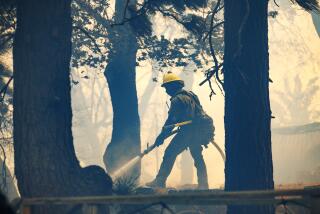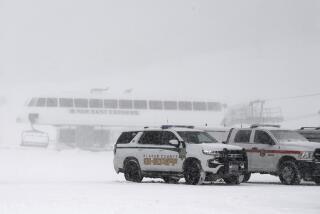Village Falls Silent After Ski Train Disaster
KAPRUN, Austria — Rescue workers braved toxic fumes and unstable wreckage Sunday to begin retrieving the charred remains of at least 155 skiers and snowboarders, including eight Americans, from the grisly tomb under Kitzsteinhorn mountain where they suffocated and burned to death a day earlier in the worst Alpine disaster in modern history.
Officials conceded that they were still uncertain of the exact number of people who were trapped in a cable car consumed by flames half a mile into a two-mile-long mountain tunnel. The list of names of presumed victims, still being withheld pending family notifications, was compiled from reports by friends of those known to have gone up the mountain early Saturday and never returned.
An eerie silence hung over this village as residents retreated to their homes and churches and most of the 2,500 tourists who had booked skiing holidays this week departed the morose community. Only the thump of military helicopters transporting disaster response workers to the glacier ski area broke the unseasonable calm.
The suspected death toll from Saturday’s disaster was initially set at about 170, based on what appeared to be a full load of passengers in the 180-person-capacity funicular car from which only eight were known to have escaped. Three other people waiting at the upper lift station also died from smoke inhalation. But authorities raised the number of survivors to 12 on Sunday and speculated that the lack of further missing-person reports could mean the car was carrying only about 165 passengers.
The painstaking process of determining who was inside the ill-fated carriage was only an “indirect identification,” Salzburg provincial Gov. Franz Schausberger explained to journalists, noting that actual forensic examination of the corpses would begin today once they were transported to a morgue in Salzburg, about 45 miles away.
“Retrieval has begun, and work will continue through the night until it is completed,” Schausberger said. The recovery was delayed, he said, because the 80-member operation had to spend most of the day securing the incinerated wreckage of the cable car to ensure that it won’t break from its burned tether and plunge down the 45-degree track to the boarding station a mile below.
Austrian Chancellor Wolfgang Schuessel arrived in this grief-stricken town to offer condolences to relatives of the victims and to reassure the outside world that Austria’s ski facilities, the bedrock of the nation’s vital tourism industry, are as safe as technology and human endeavor can make them.
The list of presumed victims included 52 Austrians, 42 Germans, 10 Japanese, eight Americans, two Slovenes, a Croat and 40 others whose nationalities had not yet been confirmed, Schausberger said. Among the Austrians was a group of 33 from the northern town of Wels who had organized their outing as an office party. In Germany, friends of world champion freestyle skier Sandra Schmitt confirmed that the 19-year-old and her parents were also among the victims.
The missing Americans were from two separate ski groups from U.S. military facilities in Germany--a family of four and an engaged couple from the Wuerzburg area, and a father and son from a military ski club in Kaiserslautern.
“It looks really grim,” said Maj. Drew Stathis, one of about two dozen members of the Wuerzburg club who decided to spend the weekend skiing. “We were told last night by the authorities here that everyone who had survived was off the mountain, and we’re still missing six from our group.”
At U.S. Army Europe headquarters in Heidelberg, Germany, officials were weighing whether to send a military forensics team to conduct the identification of American victims, said Maj. Erik Gunhus of the 1st Infantry Division.
By late Sunday, investigators had unearthed no new clues to the cause of the disaster, and Austrian media had begun demanding to know why the carriage--perhaps along with other transportation for skiers in the country--was so woefully equipped for an emergency.
But federal officials insisted that the technology used at Austria’s modern ski resorts is top-notch.
“We will have to review and investigate security procedures,” conceded Horst Kuehschelm of the national Transportation Ministry, who said he was unable to confirm whether evacuation drills had been practiced on the cable car.
The 12 people who escaped the blaze remained hospitalized with respiratory problems from toxic fumes, said Heinrich Thorni, one of the doctors treating them at the hospital in nearby Zell am See. He added that their conditions prevented them from speaking to investigators to help explain how the accident transpired and perhaps establish its cause.
As the gruesome retrieval work got underway just before nightfall, already overwhelmed psychological counselors were asked to also help some of the 80 firefighters deployed into the tunnel to bring out the bodies, said Manfred Mueller, head of the recovery operation.
“It’s psychologically very difficult for everyone involved,” said Markus Masoner, one of the professional counselors working out of an empty youth hostel that had become the gathering place for the bereaved. “Because a lot of the victims were from this area, the officials handling the information and identity lists keep encountering friends and acquaintances. It’s hard on everyone.”
Outside the youth hostel and along sidewalks, candle lanterns flickered in private tributes to those killed on the mountain. Across the country, on the second day of national mourning, black banners were draped from official buildings, and the red-white-red Austrian flag flew at half-staff. In Kaprun, organizers announced that a World Cup snowboarding event planned for Nov. 24 had been canceled.
Villagers, like their visitors, had been in shock since the accident, and local officials worried that the predictable second blow of economic losses will prolong the misery.
“We live from tourism here, especially from skiing,” said the Pinzgau district director, Walter Thaler, explaining that his region, encompassing Kaprun and four other villages, lets out 8 million overnight lodgings per year, half of them to skiers.
Although Kitzsteinhorn can also be reached by gondola lifts operating out of the same boarding station from which the doomed train departed, all skiing has been suspended for at least this week, and local officials were unsure how soon it can resume. The train and tunnel will be out of use for months, confirmed Peter Praeauer, director of the cable car service.
More to Read
Sign up for Essential California
The most important California stories and recommendations in your inbox every morning.
You may occasionally receive promotional content from the Los Angeles Times.











